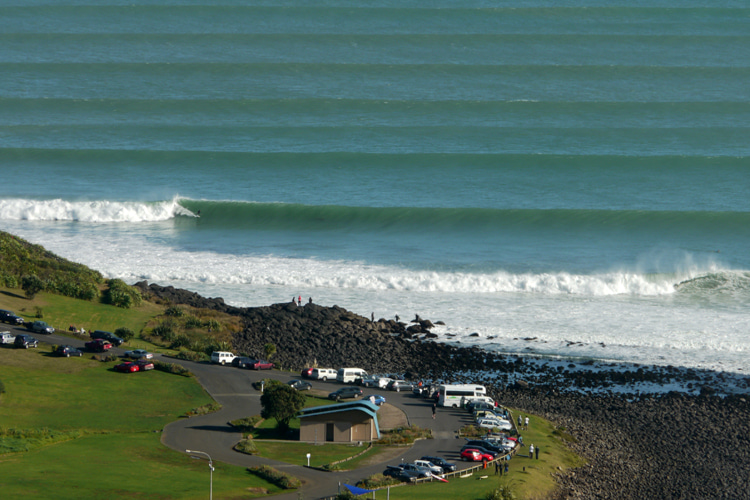Raglan is New Zealand's surfing capital. The lively coastal town is home to some of the best left-hand point breaks on the planet.
Located on the west coast of North Island's Waikato region and just 25 miles (40 kilometers) west of Hamilton, Raglan is a surfer's paradise.
With the tenth longest coastline in the world, New Zealand is an open window to nearly all South Pacific Ocean swells that populate the Ring of Fire.
Millions of years ago, the volcanic island nation split from Australia, becoming the epicenter of winds, currents, and waves traveling from all angles.
Raglan is blessed by geomorphological features and characteristics that make it one of Earth's most exciting surf spots.
You won't find many places like Manu Bay, also known as The Point, where you can catch a wave and ride it for up to 330 yards (300 meters).
The legendary left-hand point break was first documented in the 1966 Bruce Brown masterpiece "The Endless Summer."
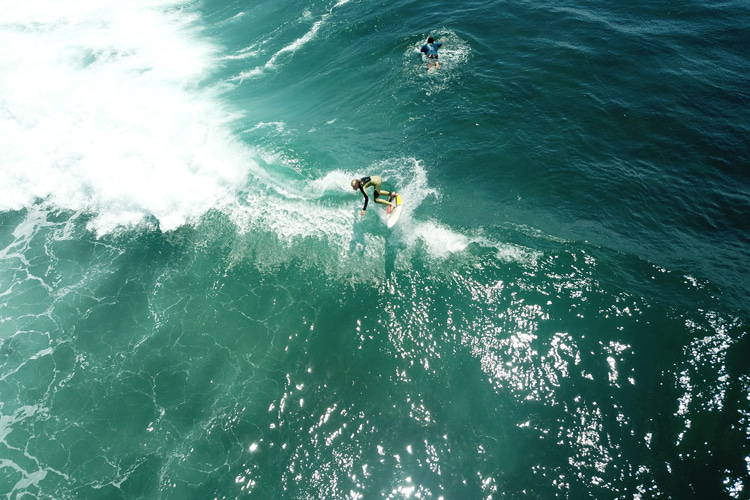
Raglan: A Laid-Back Kiwi Surf Town
Waikato, the region where Raglan sits, is constantly pummeled by swells that hit the local black sand beaches and imposing rocky headlands.
As the wave trains hug the nearby bays, they become natural surfing machines, pumping consecutive perfectly shaped ripples.
They're not only perfect but also highly accessible, gentle, and long - so long that you might quit a perfect session just because you're exhausted.
The surrounding scenario is indescribable - vast beaches, green mountains, toetoe plant dunes, sandy coves, and golden sunsets just boost the whole surfing experience.
Raglan is a laid-back surf town with a cool vibe where artists, surfers, and locals will welcome visitors from anywhere in the world.
You'll find good restaurants, cozy bars and clubs, surf shops, cafes, art corners, and the best of the Kiwi culture, just two hours drive away from the country's capital, Auckland.
The air temperate ranges from 54 °F (12 °C) in July-August to 70 °F (21 °C) in January-February.
The water temperature varies from 57 °F (14 °C) in July-August to 66 °F (19 °C) in January-February.
The best period of the year to surf Raglan is from May through August.
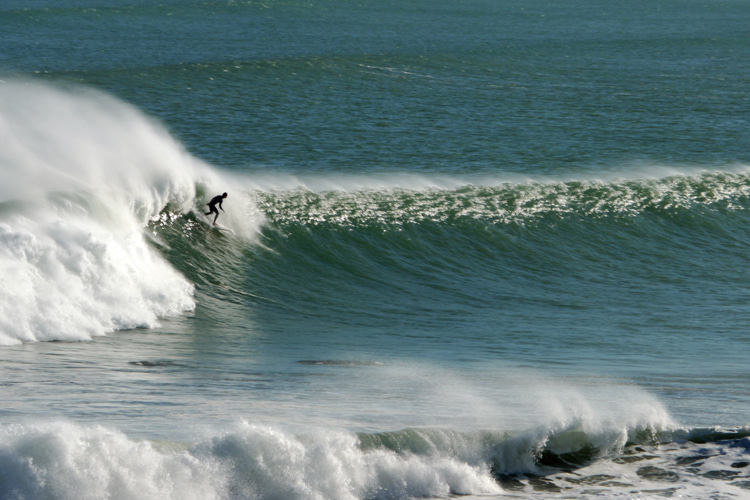
Swell and Wind
When it comes to wave quality, the Waikato region features a consistent coastline, with five out of six days showing some SW-W swell arriving.
It's a true swell magnet sandwiched between the cold of Antarctica and the heat of Australia, pinched by year-round storm systems.
A sprinkling of NW only reinforces the idyllic scenario, with wave heights of up to 25 feet and a 20-second swell period perfectly possible.
The prevalent SW-W wind shares much of the winter with E quadrant winds before reasserting dominance in the summer months.
Also, N-to-E winds blow for about a quarter of the time annually.
Raglan experiences semidiurnal tide cycles with a 3.9-meter maximum tidal range.
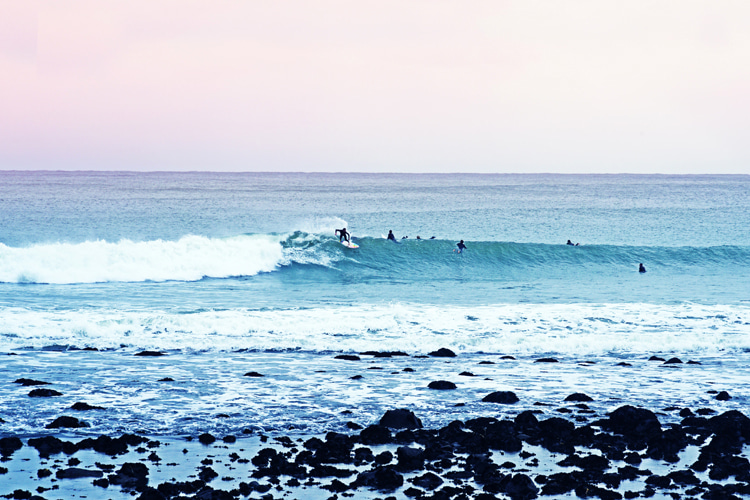
Nearby Surf Spots
Raglan is more than just a single surf break or beach - it's a series of rideable spots south and north of Tawatahi River. If you're new to the sport, you can book surf lessons at nearby surf schools.
One of the first waves that should be mentioned is Te Akau.
It's a powerful beach break north of Raglan with scattered rocks that works well on high tide, E wind, and small swells.
On our way to the Raglan, there's Mussel Rock at Rangitoto Point.
The spot lies in an area where sand commutes around the rocks with unexpected results. You might get fast barrels or slopey shoulders.
The sensitive and shifting sand banks are also present at Raglan Bar, the first break south of the Tawatahi River.
On light wind days, the spot can provide fast and hollow peaks.
As we move further south, we reach Ngarunui Beach, a secluded and long black sand strip that always serves up waves for all experience levels.
If you need a ride to the outside, let the rip in the southern corner push you to the take-off zone.
Ngarunui Beach can be crowded, and it is the ideal playground for people learning to surf on New Zealand's North Island.
If you're looking for a more relaxed, less crowded vibe, try Ruapuke Beach during summer, with NE wind and small swell.
The left-hand waves of Albatross Point are located in an area that requires access permission.
They work on more powerful swells and provide great walls of water but hollow tubes, too. The spot is known for its extreme localism.
Kiritehere Beach is another left-hand point break in the south Waikato region with a beautiful wall that shines to life at higher tides.
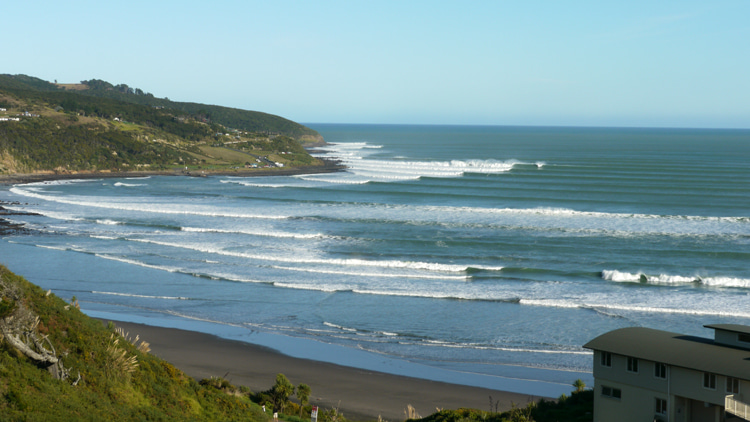
Manu Bay, Whale Bay, and Indicators: The Power Trio
Three miles (five kilometers) west of Ngarunui Beach, you'll see the iconic Manu Bay, home of Raglan's Point Boardrider surf club.
By now, you're stepping on the famous three Kiwi left-hand point breaks - Manu Bay, Whale Bay, and Indicators. It's a place for experienced surfers only.
Manu Bay
Manu Bay is the innermost of the famed surf break trio and comes alive during S-SW swells that wrap around the nearby headland.
It kicks off with a hollow barrel before bending into a walling section that can race for 330 yards (300 meters) or more past the boat ramp.
Jumping from the rocks past the take-off zone requires good timing. On an epic day, you'll enjoy 12-to-18-foot waves.
If you need a less crowded alternative, move further west toward the Boneyards section.
Whale Bay
Whale Bay's reputation is not as high as its sister waves, but it can deliver the goods at smaller sizes when it breaks close to the rocks and sections on the headland to the east of the bay.
During bigger swell days, the wall loses steepness and rolls along unless the swell is more W-NW, making it barrel over the boulders that tend to pop up.
Whale Bay is often less crowded than the other two surf breaks, giving intermediate riders more wave-riding opportunities.
Indicators
Last but not least, you have Indicators, the longest, fastest, and most critical of Raglan's point breaks.
On smaller days, the celebrated wave splits into two or three sections.
Outside Indicators starts with a heavy take-off that morphs into a hollow and deep barrel.
On big days, it will take you to Inside Indicators, a mixed section with plenty of high-performance walls, speedy barrels, and a fast and shallow end.
Larger swells will occasionally break far enough out to link up with Whale Bay - and even Manu Bay - but it's rare to be able to join the whole 1.2-mile (two-kilometer) journey.
Manu Bay, Whale Bay, and Indicators require SE winds to be perfect but can handle an SW breeze.
